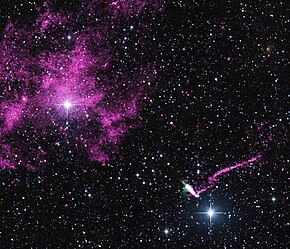
A supernova is a powerful and luminous explosion of a star. A supernova occurs during the last evolutionary stages of a massive star, or when a white dwarf is triggered into runaway nuclear fusion. The original object, called the progenitor, either collapses to a neutron star or black hole, or is completely destroyed to form a diffuse nebula. The peak optical luminosity of a supernova can be comparable to that of an entire galaxy before fading over several weeks or months.

The Crab Nebula is a supernova remnant and pulsar wind nebula in the constellation of Taurus. The common name comes from a drawing that somewhat resembled a crab with arms produced by William Parsons, 3rd Earl of Rosse, in 1842 or 1843 using a 36-inch (91 cm) telescope. The nebula was discovered by English astronomer John Bevis in 1731. It corresponds with a bright supernova recorded by Chinese astronomers in 1054 as a guest star. The nebula was the first astronomical object identified that corresponds with a historically-observed supernova explosion.
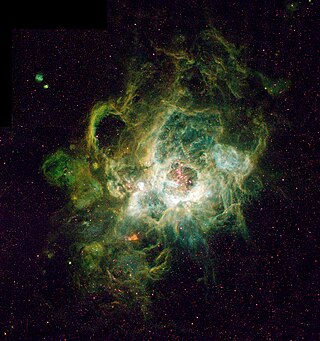
An H II region or HII region is a region of interstellar atomic hydrogen that is ionized. It is typically in a molecular cloud of partially ionized gas in which star formation has recently taken place, with a size ranging from one to hundreds of light years, and density from a few to about a million particles per cubic centimetre. The Orion Nebula, now known to be an H II region, was observed in 1610 by Nicolas-Claude Fabri de Peiresc by telescope, the first such object discovered.
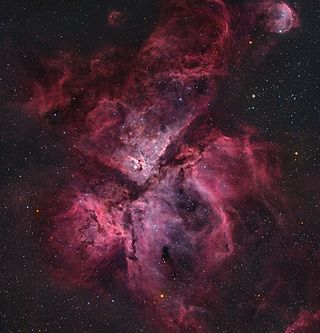
The Carina Nebula or Eta Carinae Nebula is a large, complex area of bright and dark nebulosity in the constellation Carina, located in the Carina–Sagittarius Arm of the Milky Way galaxy. The nebula is approximately 8,500 light-years (2,600 pc) from Earth.

Messier 96 is an intermediate spiral galaxy about 31 million light-years away in the constellation Leo.

NGC 6946, sometimes referred to as the Fireworks Galaxy, is a face-on intermediate spiral galaxy with a small bright nucleus, whose location in the sky straddles the boundary between the northern constellations of Cepheus and Cygnus. Its distance from Earth is about 25.2 million light-years or 7.72 megaparsecs, similar to the distance of M101 in the constellation Ursa Major. Both were once considered to be part of the Local Group, but are now known to be among the dozen bright spiral galaxies near the Milky Way but beyond the confines of the Local Group. NGC 6946 lies within the Virgo Supercluster.

A pulsar wind nebula, sometimes called a plerion, is a type of nebula sometimes found inside the shell of a supernova remnant (SNR), powered by winds generated by a central pulsar. These nebulae were proposed as a class in 1976 as enhancements at radio wavelengths inside supernova remnants. They have since been found to be infrared, optical, millimetre, X-ray and gamma ray sources.

3C 58 or 3C58 is a pulsar and supernova remnant within the Milky Way. The object is listed as No. 58 in the Third Cambridge Catalogue of Radio Sources.

W49B is a nebula in Westerhout 49 (W49). The nebula is a supernova remnant, probably from a type Ib or Ic supernova that occurred around 1,000 years ago. It may have produced a gamma-ray burst and is thought to have left a black hole remnant.

IC 443 is a galactic supernova remnant (SNR) in the constellation Gemini. On the plane of the sky, it is located near the star Eta Geminorum. Its distance is roughly 5,000 light years from Earth.

RX J0852.0−4622 is a supernova remnant. The remnant is located in the southern sky in the constellation Vela ("sail"), and sits inside the much larger and older Vela Supernova Remnant. For this reason, RX J0852.0−4622 is often referred to as Vela Junior. There have been a minority of suggestions that the remnant may be a spurious identification of a complicated substructure within the larger and better studied Vela SNR, but most studies accept that G266.2−1.2 is a SNR in its own right. Indeed, its detection in the high energy Teraelectronvolt range by the High Energy Stereoscopic System in 2005 is strong confirmation of such.
SSTGFLS J222557+601148 is a planetary nebula in the constellation Cepheus. Located between 2000 and 3000 parsecs distant from Earth, it was originally classified in 2006 as a supernova remnant. Thought to be the first supernova remnant first detected in the infrared wavelengths, the spectrum and properties of the object did not match up well with that of a typical supernova remnant, and it was reclassified as a planetary nebula in 2010. A candidate central star has been identified, with an apparent infrared magnitude of 22.4.
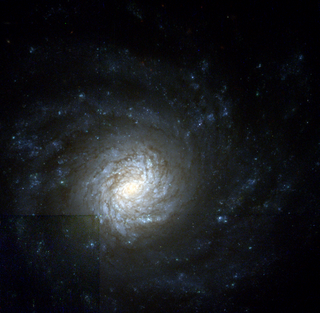
NGC 4041 is the New General Catalogue identifier for a spiral galaxy in the northern circumpolar constellation of Ursa Major. It is located an estimated 70 million light years from the Sun. The morphological classification of SA(rs)bc indicates this is a spiral galaxy the lacks a bar; the 'rs' means it has a weakly-formed ring structure, and the 'bc' indicates the spiral arms are moderately to loosely wound.
Laura A. Lopez is an associate professor of astronomy at Ohio State University studying the life cycle of stars. She was awarded the Annie Jump Cannon Award in Astronomy in 2016, which is awarded by the American Astronomical Society (AAS) for outstanding research and promise for future research by a postdoctoral woman researcher.

CK Carinae is a variable star in the constellation Carina, the keel of Argo Navis. It is a member of the star association Carina OB1-D, at a distance of around 2,300 parsecs or 7,500 light years.

NGC 5281 is an open cluster in the constellation Centaurus. It was discovered by Nicolas Louis de Lacaille in 1751-1752 from South Africa, and catalogued it as Lacaille I.7. NGC 5281 is located three and a quarter degrees southwest of Beta Centauri. Under dark skies, it is bright enough to be spotted with naked eye, appearing as a 6th magnitude star.
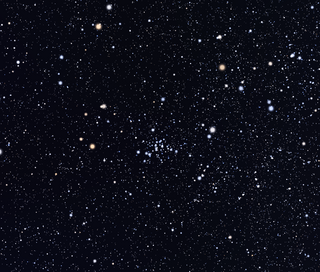
NGC 4103 is an open cluster in the constellation Crux. It was discovered by James Dunlop in 1826. It is located approximately 5,000 light years away from Earth, in the Carina-Sagittarius arm.

HD 73882 is a visual binary system with the components separated by 0.6″ and a combined spectral class of O8. One of stars is an eclipsing binary system. The period of variability is listed as both 2.9199 days and 20.6 days, possibly due to the secondary being a spectroscopic binary star.
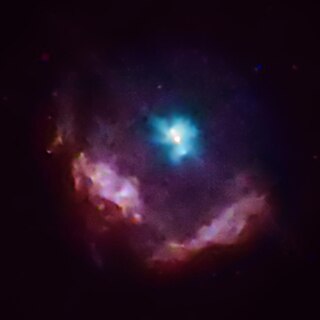
Kesteven 75, abbreviated as Kes 75 and also called SNR G029.7-00.3, G29.7-0.3 and 4C -03.70, is a supernova remnant located in the constellation Aquila.
